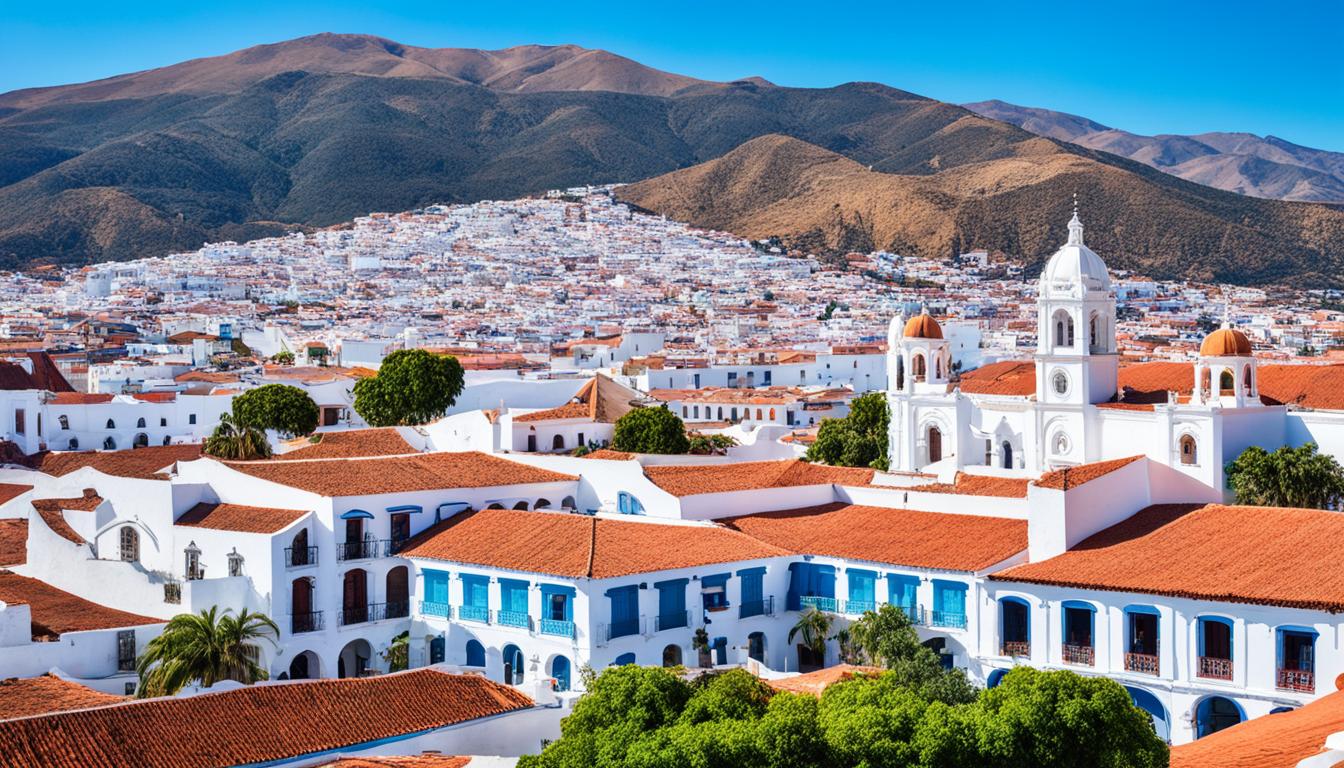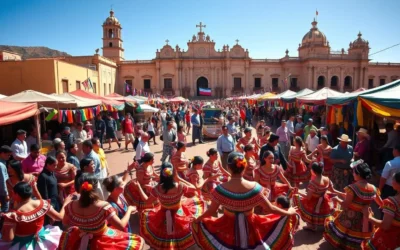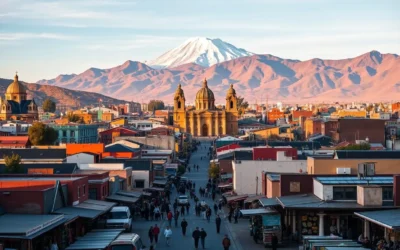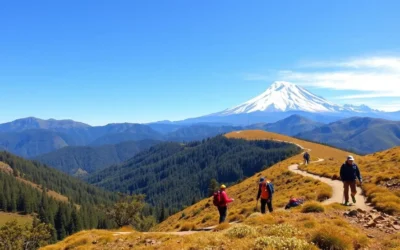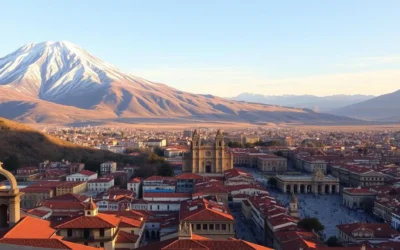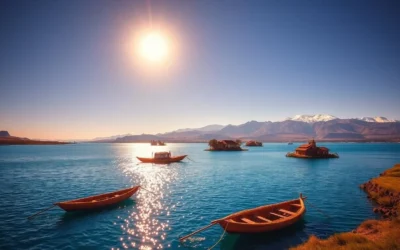✓ Accommodations✓ Flights✓ Rental Cars
Imagine a city where time seems to stand still. Sucre, Bolivia’s charming constitutional capital, is such a place. It’s where colonial architecture and indigenous traditions live together in harmony. This city captivates the senses and offers a rich experience for all travelers.
From exploring the historic city center to finding ancient dinosaur footprints, Sucre is a city that will amaze you. But what makes it a must-visit spot in Bolivia? Let’s find out the top attractions and experiences that highlight Sucre’s best.
Key Takeaways
- Discover Sucre’s rich colonial heritage and its role in Bolivia’s independence at the Casa de la Libertad
- Immerse yourself in indigenous culture at the Museo Indigena, showcasing traditional Bolivian art and textiles
- Explore the prehistoric wonders of the Parque Cretacico, home to ancient dinosaur footprints
- Savor the culinary delights of Sucre, from traditional llama stews to the renowned Tarabuco textiles
- Witness the stunning panoramic views of Sucre from the La Recoleta Viewpoint and the Rooftop of San Felipe de Neri Convent
Why Visit Sucre, Bolivia?
Sucre, known as “La Ciudad Blanca” or the “White City,” is in the heart of Bolivia. It’s a place where history, culture, and beauty come together. Founded in 1538, Sucre was key in Bolivia’s fight for freedom. It’s where the country’s constitution was born.
The city’s buildings are white-washed, with terracotta roofs. This gives Sucre a charming look that takes you back in time. The Andes Mountains surround it, making the climate pleasant all year.
This makes Sucre perfect for outdoor activities and getting to know the culture. You’ll love the arts, food, and historical sites here. They will all leave a mark on you.
With about 300,000 people, Sucre is much smaller than La Paz, the capital. This lets you see everything at your own pace. The city center is even a UNESCO World Heritage site.
Visiting Sucre means seeing its beautiful colonial buildings, diving into Bolivian culture, or going on outdoor adventures. It’s a key spot for anyone wanting to see South America’s heart.
“Sucre is a city that transports you to a bygone era, with its captivating colonial architecture and rich cultural heritage.”
Explore the Historic City Center
The heart of Sucre is its historic city center. Here, you can dive into the city’s history and admire its architecture. The center piece is the lively Plaza 25 de Mayo, named for Bolivia’s first independence in 1809. The plaza is flanked by key buildings like the Casa de la Libertad, where the independence was signed in 1825, and the beautiful Metropolitan Cathedral, a symbol of religious architecture since the 16th century.
Walking through the streets, you’ll see the colonial architecture, cobblestone lanes, and the lively local scene. The Plaza 25 de Mayo is a center of activity, letting you experience Sucre’s daily life and cultural heritage.
Plaza 25 de Mayo
The Plaza 25 de Mayo is Sucre‘s vibrant square. It’s the heart of the historic center, surrounded by grand buildings and the famous Metropolitan Cathedral. The plaza is alive with markets, street performers, and rallies all year.
Casa de la Libertad
The Casa de la Libertad, or House of Liberty, is a key spot in Sucre. It’s where Bolivia declared independence in 1825, a crucial moment in the fight against Spanish rule.
Metropolitan Cathedral
The Metropolitan Cathedral of Sucre showcases colonial architecture. It’s a symbol of the city’s religious past. This 16th-century cathedral boasts beautiful facades, detailed stonework, and a tall bell tower visible from the historic city center.
“Wandering the streets of Sucre’s historic city center is like taking a step back in time, where the past and present coexist in perfect harmony.”
Discover Bolivian Culture and Traditions
Sucre, Bolivia, is a city full of rich culture. The Museo Indigena (Museum of Indigenous Art) is a great place to dive into this heritage. It takes you on a journey through the textiles of Bolivia’s indigenous people.
At the museum, you’ll see colorful weavings, rugs, and ancient artifacts. These items show the skill and importance of weaving in Bolivian culture. The museum has nine rooms filled with these amazing pieces, helping you appreciate Bolivian art and culture more.
Museo Indigena
The Museo Indigena is full of indigenous art, textiles, and weaving traditions. It’s a place where vibrant colors and intricate patterns tell stories. Visitors are sure to be amazed by the beauty and history of each piece.
“The museum’s exhibits offer a fascinating glimpse into the country’s living traditions, providing visitors with a deeper understanding of the Bolivian culture and traditions.”
If you love art, history, or just want to learn about Bolivia’s culture, the Museo Indigena is a must-see in Sucre. You’ll be moved by the beauty and importance of these indigenous art pieces.
Sucre, Bolivia: Best Things to Do – Top Picks
Sucre, Bolivia, is a city full of experiences for all kinds of travelers. You can explore colonial architecture, learn about the country’s history, go on outdoor adventures, or try the local food. Sucre has something for everyone.
Discover Sucre’s Historic City Center
Begin by walking through Sucre’s historic city center, a UNESCO World Heritage site. See the beautiful colonial buildings and visit the famous Plaza 25 de Mayo. This square is the city’s heart, with landmarks like the Casa de la Libertad and the Metropolitan Cathedral nearby.
Explore Bolivian Culture and Traditions
Learn about Bolivia’s culture at the Museo Indigena, or Museum of Indigenous Art. This museum has a great collection of indigenous art, textiles, and crafts. It shows the country’s rich cultural heritage.
Outdoor Adventure at Parque Cretacico
Not far from the city, Parque Cretacico is a place for outdoor fun. It has the world’s largest dinosaur footprint collection, with over 5,000 tracks. Join a tour to see these ancient footprints and life-sized dinosaur models.
Panoramic Views and Sunsets
For amazing views, go to the La Recoleta Viewpoint or the San Felipe de Neri Convent‘s rooftop. These spots offer great views of the city and mountains. They’re perfect for watching the sunset over Sucre.
Sucre is perfect for history lovers, nature fans, or anyone wanting to experience Bolivia’s culture. It has colonial charm, a rich heritage, and lots of activities. Sucre is a city you must visit in Bolivia.
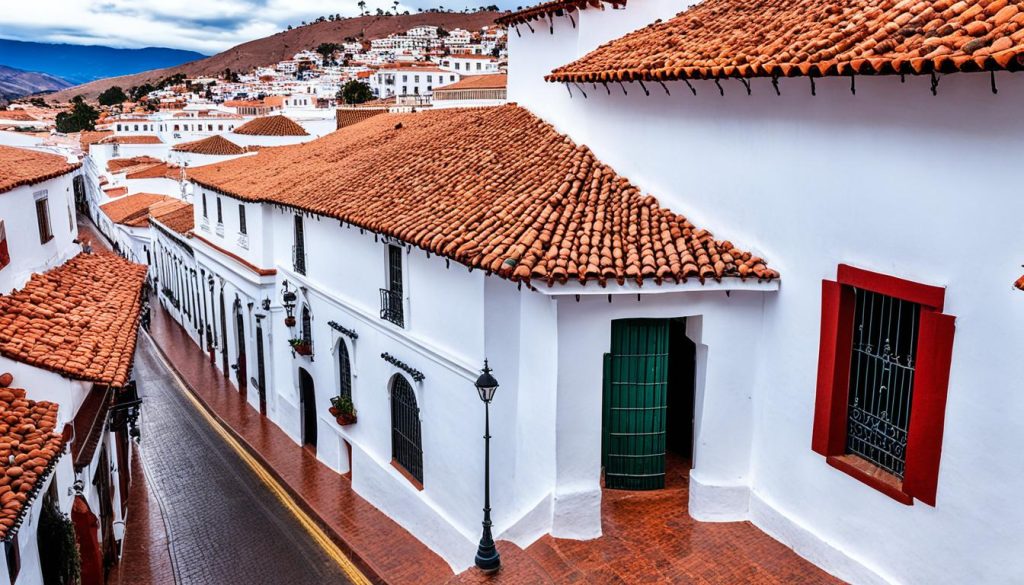
Outdoor Adventures
Beyond Sucre’s charming streets, a world of outdoor adventures awaits. The Parque Cretacico is a top spot for those seeking adventure. It’s near the city and has over 5,000 dinosaur footprints from 15 species.
At Parque Cretacico, you can join guided tours to see the fossilized footprints up close. You’ll also find life-sized dinosaur models. This gives you a peek into the past.
If you love paleontology or the Mesozoic era, Parque Cretacico is a must-visit. It’s an outdoor gem that lets you explore the area’s geological history. You’ll feel like you’ve traveled back in time.
| Attraction | Features | Cost |
|---|---|---|
| Parque Cretacico | Over 5,000 dinosaur footprints from 15 species, guided tours, life-sized dinosaur models | Approximately 30 BOB ($4.50 USD) |
The Parque Cretacico in Sucre, Bolivia, is an unforgettable adventure spot. It’s perfect for explorers and curious travelers alike. You’ll be amazed by the ancient wonders that have lasted for millions of years.
Culinary Delights
Visiting Sucre, Bolivia’s constitutional capital, means trying its tasty local food. This city is a center for Bolivia’s diverse food traditions. You’ll find many delicious dishes that will make your mouth water.
Try the famous salteñas (savory pastries) and sopa de mani (peanut soup). Don’t miss the papas rellenas (stuffed potatoes) and mondongo (tripe stew). These dishes will make you want more. You can taste fresh produce, meats, and local treats at the central market. Or, enjoy meals at charming cafes and restaurants to dive deep into Bolivian food culture.
| Dish | Description |
|---|---|
| Salteñas | Savory pastries filled with a variety of ingredients, including meat, vegetables, and spices. |
| Sopa de mani | A hearty peanut-based soup, often served with boiled potatoes and a sprinkling of cheese. |
| Papas rellenas | Stuffed potatoes, typically filled with a mixture of ground meat, vegetables, and spices. |
| Mondongo | A tripe stew made with various vegetables and herbs, offering a unique and flavorful culinary experience. |
At the vibrant central market in Sucre, you can try fresh produce, meats, and local treats. Or, dine at one of the city’s charming cafes and restaurants. This way, you’ll fully experience the flavors of Bolivian culture.
“Sucre’s local cuisine is a true reflection of the country’s rich cultural heritage, showcasing the diverse flavors and traditions that make Bolivian food so unique and captivating.”
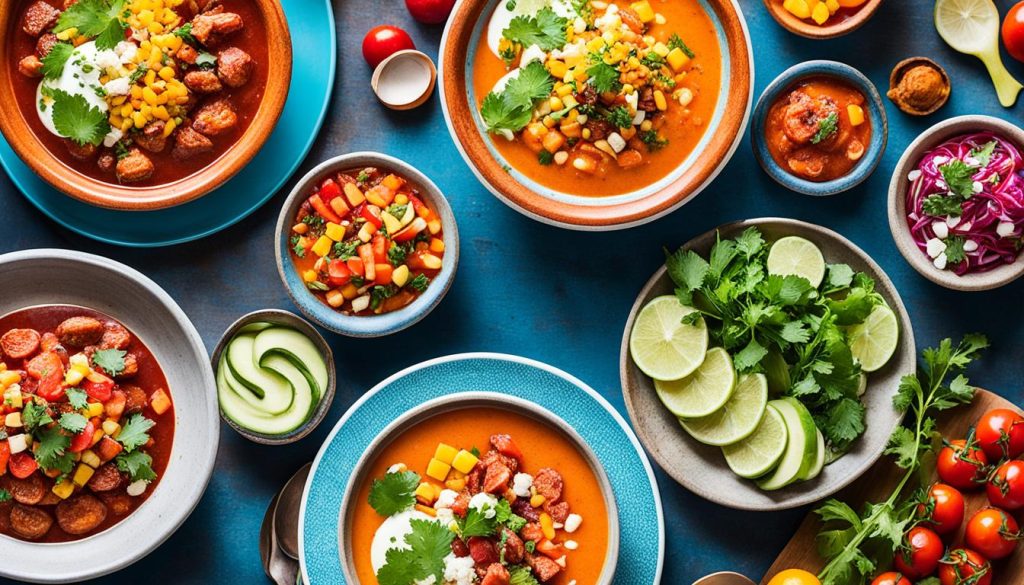
Panoramic Views and Sunsets
Sucre is known for its stunning views and beautiful sunsets. It’s a great place to see the city’s beauty. The best spots for this are the
La Recoleta Viewpoint
and the
Rooftop of San Felipe de Neri Convent
The La Recoleta Viewpoint sits on a hill, giving you a wide view of Sucre and the Andes. It’s a 25-minute walk up, and it costs about 17 BOB (around $3 USD) for visitors.
At the San Felipe de Neri Convent, you can see the city’s red roofs and church spires from the rooftop. Getting up there costs 17 BOB (≈ 3 USD) for visitors.
Whether you’re looking at the panoramic views or just walking around, Sucre’s beauty will amaze you. It’s a place that leaves a lasting impression.
“Sucre’s breathtaking views and vibrant sunsets are a true feast for the senses, making it a must-visit destination for anyone seeking to immerse themselves in the heart of Bolivia’s cultural heritage.”
Colonial Architecture and Museums
Sucre, the capital of Bolivia, is full of colonial architecture and museums. These places show off the country’s deep history. The Convento San Felipe de Neri is a key spot, built in the 17th century. It’s a beautiful example of religious architecture from that time.
Convento San Felipe de Neri
The Convento San Felipe de Neri is a gem. It has beautiful wood carvings and elegant arches. Inside, you can see how it was made and learn about its past. Climbing to the rooftop gives you amazing views of Sucre.
Cementerio General
Don’t miss the Cementerio General in Sucre. It’s a big cemetery where many important people are buried. The fancy tombs and graves show off Sucre’s high society. It’s a chance to see the city’s culture and history up close.
| Attraction | Entrance Fee | Hours of Operation |
|---|---|---|
| Convento San Felipe de Neri | Approx. $3 USD for foreigners | Daily, 2:30 p.m. to 5:30 p.m. |
| Cementerio General | Free admission | Daily, open year-round |
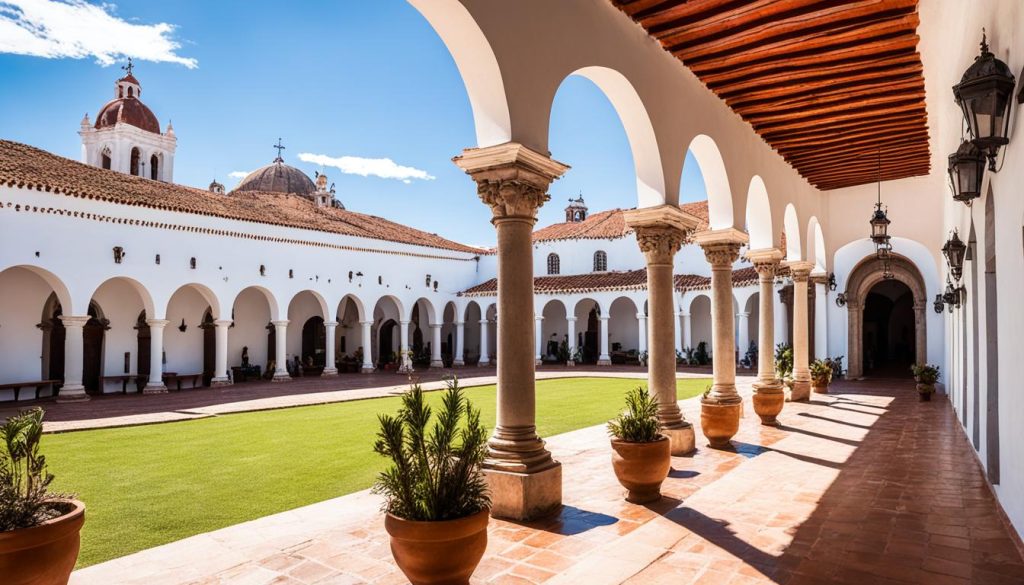
“Sucre’s captivating architecture and rich history are on full display in the city’s impressive colonial buildings and museums.”
Explore the Surroundings
Sucre itself is full of attractions, but it’s also great for exploring around. Just a short trip from downtown, you’ll find the Castillo de la Glorieta. This 19th-century castle was once a military hospital.
In the heart of Sucre, the Parque Bolivar is a must-see. It has a copper-colored replica of the Eiffel Tower made by Gustave Eiffel. This park is loved by locals and tourists for its peaceful vibe.
Whether you’re on day trips or enjoying Sucre, there’s always something new to discover. The city and its surrounding areas are full of opportunities for adventure and learning.
- Sucre, Bolivia is a UNESCO World Heritage Site.
- Parque Simón Bolívar has a red iron structure designed by Gustav Eiffel.
- Sucre is known for street art murals in its outer neighborhoods.
- Sucre is one of the most popular places in South America for learning Spanish.
“Sucre’s charm lies not just within the city limits, but in the captivating surrounding areas that offer a glimpse into Bolivia’s rich history and natural wonders.” – Jane Doe, travel writer
Conclusion
As your journey through Sucre, Bolivia’s charming constitutional capital, comes to an end, you’ll see why it’s a top travel spot. The city’s historic center is filled with beautiful colonial architecture. It’s a place where the past and present meet in a special way.
You might have visited the Museo Indigena, seen the amazing views from La Recoleta Viewpoint, or tried the local food at Mercado Central. Sucre has something for every kind of traveler. Being a UNESCO World Heritage site, it lets you see Bolivia’s rich history and its lively culture.
When you leave Sucre, remember the friendly locals, the stunning views, and the feeling of discovery. Sucre is a city that mixes Bolivian culture, beautiful sights, and outdoor fun. It’s a place that will stay with you, touching your heart and mind deeply.
FAQ
What is Sucre, Bolivia known for?
What are the top attractions in Sucre?
What can I expect to see and do in Sucre?
How can I learn about Bolivian culture in Sucre?
What outdoor activities can I enjoy in Sucre?
What type of cuisine can I expect in Sucre?
The above is subject to change.
Check back often to TRAVEL.COM for the latest travel tips and deals.
